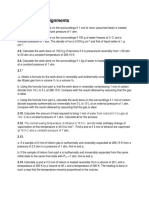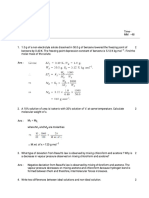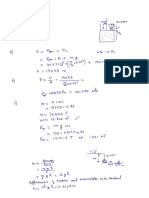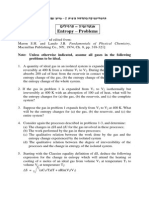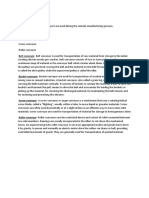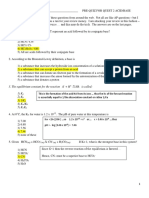0 ratings0% found this document useful (0 votes)
107 viewsCH 2 Assignment PDF
CH 2 Assignment PDF
Uploaded by
Aftab57.1. The document provides 12 calculation problems involving properties of substances such as water, mercury, methyl chloride, sulfur hexafluoride, n-butane, ethane, ethylene, and propane under various temperature and pressure conditions.
2. The calculations involve determining values such as volume, work, pressure, enthalpy, and entropy using equations of state, compressibility, thermal expansion, and properties of the substances.
3. The answers to the problems are provided in parentheses at the end of each problem statement.
Copyright:
© All Rights Reserved
Available Formats
Download as PDF, TXT or read online from Scribd
CH 2 Assignment PDF
CH 2 Assignment PDF
Uploaded by
Aftab57.0 ratings0% found this document useful (0 votes)
107 views1 page1. The document provides 12 calculation problems involving properties of substances such as water, mercury, methyl chloride, sulfur hexafluoride, n-butane, ethane, ethylene, and propane under various temperature and pressure conditions.
2. The calculations involve determining values such as volume, work, pressure, enthalpy, and entropy using equations of state, compressibility, thermal expansion, and properties of the substances.
3. The answers to the problems are provided in parentheses at the end of each problem statement.
Original Title
Ch-2-Assignment.pdf
Copyright
© © All Rights Reserved
Available Formats
PDF, TXT or read online from Scribd
Share this document
Did you find this document useful?
Is this content inappropriate?
1. The document provides 12 calculation problems involving properties of substances such as water, mercury, methyl chloride, sulfur hexafluoride, n-butane, ethane, ethylene, and propane under various temperature and pressure conditions.
2. The calculations involve determining values such as volume, work, pressure, enthalpy, and entropy using equations of state, compressibility, thermal expansion, and properties of the substances.
3. The answers to the problems are provided in parentheses at the end of each problem statement.
Copyright:
© All Rights Reserved
Available Formats
Download as PDF, TXT or read online from Scribd
Download as pdf or txt
0 ratings0% found this document useful (0 votes)
107 views1 pageCH 2 Assignment PDF
CH 2 Assignment PDF
Uploaded by
Aftab57.1. The document provides 12 calculation problems involving properties of substances such as water, mercury, methyl chloride, sulfur hexafluoride, n-butane, ethane, ethylene, and propane under various temperature and pressure conditions.
2. The calculations involve determining values such as volume, work, pressure, enthalpy, and entropy using equations of state, compressibility, thermal expansion, and properties of the substances.
3. The answers to the problems are provided in parentheses at the end of each problem statement.
Copyright:
© All Rights Reserved
Available Formats
Download as PDF, TXT or read online from Scribd
Download as pdf or txt
You are on page 1of 1
Assignment for Chapter 2
(Answers are in parenthesis)
1. Express the volume expansivity and the isothermal compressibility as functions of density ρ and
its partial derivatives. For water at 323K (50oC) and 1 bar, κ = 44.18x10-6 bar-1. To what
pressure must water be compressed at 323 K (50oC) to change its density by 1%? Assume that
κ is independent of P. [226.2 bar]
c
2. For liquid water the isothermal compressibility is given by: κ =
V ( P + b)
where c, b are functions of temperature only. If 1 kg of water is compressed isothermally and
reversibly from 1 to 500 bars at 333K, how much work is required? At 333K, b = 2700 bar and
c = 0.125 cm-3 g-1. [0.516 J/gm]
3. Calculate the reversible work done in compressing 0.0283 m3 of mercury at a constant
temperature of 0oC from 1 atm to 3000 atm. The isothermal compressibility of mercury at 0oC
is: κ = 3.9 x 10-6 -0.1 x 10-9 P; where P is in atm and κ is in atm-1. [0.52J]
4. A substance for which κ is a constant undergoes an isothermal, mechanically reversible process
from initial state (P 1 , V 1 ) to final state (P 2 , V 2 ), where V is molar volume. (a) Starting with the
definition of κ, show that the path of the process is described by: V = A(T) exp(-κP); (b)
Determine an exact expression which gives the isothermal work done on 1 mol of this constant
-κ substance. [ PV 1 1 − PV2 2 + (V1 − V2 ) / κ ]
5. For methyl chloride at 373.15 K (100oC) the second and third virial coefficient s are: B = -242.5
cm3 mol-1; C = 25 200 cm6 mol-2. Calculate the work of mechanically reversible, isothermal
compression of 1 mol of methyl chloride 1 bar to 55 bars at 100oC. Base calculations on the
following form of the virial equation: Z =1 + B + C [12.62 kJ/mol, 12.596 kJ/mol]
V V2
o
6. Calculate V for sulfur hexafluoride at 75 C and 15 bar by the following equations: (a) The
truncated virial equation with the following experimental values of virial coefficients: B = -194
cn3 mol-1; C = 15300 cm6 mol-2 (b) The truncated virial equation, with a value of B from the
generalized Pitzer correlation. (c) The Redlich/Kwong equation (d) The Soave/Redlich/Kwong
equation (e) The Peng/Robinson equation. [1722, 1734, 1714, 1727, 1701cm3/mol]; For sulfur
hexafluoride, T c = 318.7 K, P c = 37.6 bar, V c = 198 cm3 mol-1, and ω = 0.286.
7. Use the Soave/Redlich/Kwong equation to calculate the molar volumes of saturated liquid and
saturated vapor for propane at 40C for which the vapour pressure is 13.71 bar. [104.7, 1480.7
cm3/mol]
8. A 30-m3 tank contains 14 m3 of liquid n-butane in equilibrium with its vapor at 298.15 K
(25oC). Estimate the mass of n-butane vapor in the tank. The vapor pressure of n-butane at the
given temperature is 2.43 bar. [98.2 kg]
9. A rigid 0.35-m3 vessel at 25oC and 2200kpa holds ethane; what pressure develops if it is heated
to 220oC? [42.7 bar]
10. To what pressure does one fill a 0.15-m3 vessel at 25oC for storing 40 kg of ethylene in it? [79.7
bar]
11. Liquid water at 25oC and 1 bar fills a rigid vessel. If heat is added to the water until its
temperature reaches 50oC, what pressure is developed? The average value of β between 25 and
50oC is 36.2 x 10-5 K-1. The value of κ at 1 bar and 50oC is 4.42 x 10-5 bar-1, and may be
assumed independent of P. The specific volume of liquid water at 25oC is 1.0030 cm3 g-1. [206
bar]
12. A two-phase system of liquid water and water vapor in equilibrium at 8000 kPa consists of
equal volumes of liquid and vapor. If the total volume is 0.15 m3, what is the total enthalpy Ht
and what is the total entropy St? [80173.5kJ, 192.15 kJ/K]
You might also like
- Structure-Property Relationships in PolymersDocument233 pagesStructure-Property Relationships in PolymersAvishkar Tambade100% (2)
- AGT ExamDocument5 pagesAGT ExamAmirul Aizad Bin Kamaruzaman100% (1)
- PIChE National Quiz Bowl Part 3Document56 pagesPIChE National Quiz Bowl Part 3joemarcacnio100% (1)
- Quiz No 3Document3 pagesQuiz No 3von_science08No ratings yet
- CL 253 Tut 2Document2 pagesCL 253 Tut 2yudha7wira7rahman100% (1)
- 1 PEAB ZC311 Assignment IDocument2 pages1 PEAB ZC311 Assignment IDedy Mustafa0% (1)
- 05-1-Collection of Problems PDFDocument15 pages05-1-Collection of Problems PDFFistia MaulinaNo ratings yet
- 2nd AssignmentDocument1 page2nd AssignmentM Helmy AdityaNo ratings yet
- BT Hoa Ly 1Document22 pagesBT Hoa Ly 1Minh ThưNo ratings yet
- 1 PEAB ZC311 Assignment IDocument2 pages1 PEAB ZC311 Assignment IM Helmy Aditya100% (1)
- CHEMICAL THERMODYNAMICS (PPS) (N)Document19 pagesCHEMICAL THERMODYNAMICS (PPS) (N)kirtibalathakur6No ratings yet
- Tutorials For ChemicalthermodynamicsDocument20 pagesTutorials For Chemicalthermodynamicselisee tsokezoNo ratings yet
- Chemical-Engineering-Thermodynamics-Document6 pagesChemical-Engineering-Thermodynamics-fauzdarsachin6505No ratings yet
- CHEG 211 Chemical Process Calculation Homework #1Document2 pagesCHEG 211 Chemical Process Calculation Homework #1ramesh pokhrelNo ratings yet
- Volumetric Properties of Pure FluidsDocument3 pagesVolumetric Properties of Pure Fluidscarl0% (1)
- Tutorial 3Document2 pagesTutorial 3masungabraidenNo ratings yet
- Price2e Exercises ch05Document2 pagesPrice2e Exercises ch05Lê Anh MịnhNo ratings yet
- Assignment 1 - 14-09-2021Document2 pagesAssignment 1 - 14-09-2021Abhishek GuptaNo ratings yet
- THERMODocument2 pagesTHERMOcarlNo ratings yet
- Tutorial 3 - Questions Only - PVT Behavior - Ideal Gas - Virial EOSDocument5 pagesTutorial 3 - Questions Only - PVT Behavior - Ideal Gas - Virial EOSMihir Kumar Mech100% (1)
- Tuttherm2 PDFDocument6 pagesTuttherm2 PDFPrabir BanerjeeNo ratings yet
- Question 1399058Document8 pagesQuestion 1399058rajputabhishek71708No ratings yet
- hw3 PDFDocument2 pageshw3 PDFRohit SharmaNo ratings yet
- PS-4-Spring - 2015Document2 pagesPS-4-Spring - 2015agu josephNo ratings yet
- Asignment - Chapter 2Document9 pagesAsignment - Chapter 2Nguyễn Đạt100% (1)
- Thermo 1Document2 pagesThermo 1Diwas GhimireNo ratings yet
- ProbSet 1Document3 pagesProbSet 1LeMon chimchimNo ratings yet
- Chapter 6Document18 pagesChapter 6Nurhayati100% (1)
- INME 4045 - Chapter 3 - Suggested ProblemsDocument2 pagesINME 4045 - Chapter 3 - Suggested ProblemsAmanda SotoNo ratings yet
- HW-04Document2 pagesHW-04jorge isaiasNo ratings yet
- Tarea 5 TermodinamicaDocument4 pagesTarea 5 TermodinamicaMario GonzalezNo ratings yet
- Physical Chemistry Reference 2Document33 pagesPhysical Chemistry Reference 2Kuo SarongNo ratings yet
- Soln Week 1 XiiDocument20 pagesSoln Week 1 XiiAjay MishraNo ratings yet
- Problem Set 11 Solutions 2Document7 pagesProblem Set 11 Solutions 2pasa390% (1)
- CHE 311 - PROBSET Internal-Energy PDFDocument1 pageCHE 311 - PROBSET Internal-Energy PDFKier Deo NitafanNo ratings yet
- 23mee202et Questionbooklet-2-1Document9 pages23mee202et Questionbooklet-2-1rethinagiriswaransheshanthNo ratings yet
- ExamplesDocument34 pagesExamplesChandraprakashAgrawalNo ratings yet
- Chem112 Tutorial Questions-1Document13 pagesChem112 Tutorial Questions-1Gloria BrodaNo ratings yet
- Chem 73 PS2 2017 PDFDocument2 pagesChem 73 PS2 2017 PDFImee Kassandra Estomo CachoNo ratings yet
- HW Assignment 4 S2011Document1 pageHW Assignment 4 S2011Joanne ChangNo ratings yet
- Tuttherm 2Document6 pagesTuttherm 2Lin Xian XingNo ratings yet
- KKKR2383 Example Questions For Chapter I PDFDocument4 pagesKKKR2383 Example Questions For Chapter I PDFmasmashitahNo ratings yet
- 23mee202et Questionbooklet-2Document7 pages23mee202et Questionbooklet-2rethinagiriswaransheshanthNo ratings yet
- Tutorial - 1 (Section-A)Document2 pagesTutorial - 1 (Section-A)Always INDIANNo ratings yet
- 03 - Ans To Gaseous State Supplemtary QN - 2012Document4 pages03 - Ans To Gaseous State Supplemtary QN - 2012caspersoongNo ratings yet
- TDCE Question Bank - 2018 Unit IDocument11 pagesTDCE Question Bank - 2018 Unit IvinodNo ratings yet
- Department of Chemical Engineering, NITK Tutorial-VIIDocument2 pagesDepartment of Chemical Engineering, NITK Tutorial-VIINandita Chouhan0% (1)
- Entropy Problems AnswersDocument6 pagesEntropy Problems AnswersTots HolaresNo ratings yet
- 化熱chapt3Document5 pages化熱chapt3卓冠妤No ratings yet
- Parallel Flow, A (m2) 2.624 Counter Flow, A (m2) 2.434 Shell and Tube HX, A (m2) 2.523Document4 pagesParallel Flow, A (m2) 2.624 Counter Flow, A (m2) 2.434 Shell and Tube HX, A (m2) 2.523Chinwuba Samuel EbukaNo ratings yet
- Day 1 CalculationsDocument10 pagesDay 1 CalculationsAnonymous f4e1pzrwNo ratings yet
- ME 301 HW#6 Due: Monday 3/19/2018: C C H HDocument1 pageME 301 HW#6 Due: Monday 3/19/2018: C C H HfNo ratings yet
- Taller Fisicoquimica TermoDocument6 pagesTaller Fisicoquimica TermoWilo JaraNo ratings yet
- Reviewlecture-I 20081001 48e3c2399f4d65 74115154Document37 pagesReviewlecture-I 20081001 48e3c2399f4d65 74115154Austin BarrilleauxNo ratings yet
- Problems 2 1st Law PDFDocument10 pagesProblems 2 1st Law PDFKrystel Monica Manalo0% (1)
- Assignment - 6 Chemical Engineering Principles - Ii Self-Assessment Tests (Sats) Section-4.1Document7 pagesAssignment - 6 Chemical Engineering Principles - Ii Self-Assessment Tests (Sats) Section-4.1Ali Hamza ManzoorNo ratings yet
- Tutorial Chapter 2Document2 pagesTutorial Chapter 2Nur KamiliaNo ratings yet
- Exam I - SolutionsDocument34 pagesExam I - Solutionshy2023056744No ratings yet
- COMPULSARY SUMS (ln-6,7,8,9)Document5 pagesCOMPULSARY SUMS (ln-6,7,8,9)rkivln.gklnNo ratings yet
- Lista 1Document2 pagesLista 1Daniel AlvesNo ratings yet
- A Modern Course in Statistical PhysicsFrom EverandA Modern Course in Statistical PhysicsRating: 3.5 out of 5 stars3.5/5 (2)
- CH 7 Assignment PDFDocument3 pagesCH 7 Assignment PDFAftab57.No ratings yet
- Chapter 8 Assignment (Answers Are in Parenthesis)Document2 pagesChapter 8 Assignment (Answers Are in Parenthesis)Aftab57.No ratings yet
- CH 6 AssignmentDocument2 pagesCH 6 AssignmentArpit PatelNo ratings yet
- CH 4 Assignment PDFDocument2 pagesCH 4 Assignment PDFAftab57.No ratings yet
- CH 5 Assignment PDFDocument1 pageCH 5 Assignment PDFAftab57.No ratings yet
- Conveyors Mechanical OpertaionDocument1 pageConveyors Mechanical OpertaionAftab57.No ratings yet
- 04 - Modul A + Kimia Tg4Document26 pages04 - Modul A + Kimia Tg4yannNo ratings yet
- 13.2 Characteristic Organic ReactionsDocument45 pages13.2 Characteristic Organic Reactionssafiya_91No ratings yet
- User Guide: Elcometer 138Document140 pagesUser Guide: Elcometer 138Lexa CauchoNo ratings yet
- DSM 0391.1 - CoMoCrSi Triballoy - PowdersDocument5 pagesDSM 0391.1 - CoMoCrSi Triballoy - PowdersApichitNo ratings yet
- Heat Balance GCLDocument6 pagesHeat Balance GCLIrshad HussainNo ratings yet
- Simbarashe Makunde 3309508 Wetted Wall Column Experiment 4: Table 1Document6 pagesSimbarashe Makunde 3309508 Wetted Wall Column Experiment 4: Table 1Raza MutahirNo ratings yet
- EnergyDocument35 pagesEnergyRamin ShabNo ratings yet
- Practical-1 Sodium HydroxideDocument2 pagesPractical-1 Sodium HydroxideAbdulbhaiNo ratings yet
- Microsoft PowerPoint - Module 4 - 2 Effects ChristeynsDocument15 pagesMicrosoft PowerPoint - Module 4 - 2 Effects ChristeynsLê LợiNo ratings yet
- Lec 11 1Document21 pagesLec 11 1rozNo ratings yet
- Solution of Mole AssignmentDocument8 pagesSolution of Mole AssignmentPrerna RathiNo ratings yet
- Tutorial 2071 PDFDocument24 pagesTutorial 2071 PDFPrabin Acharya100% (1)
- LyophilisationDocument2 pagesLyophilisationVargheseNo ratings yet
- CHEM 2014 F.4 First Term Chem Set 1 PDFDocument12 pagesCHEM 2014 F.4 First Term Chem Set 1 PDFChan KyleNo ratings yet
- Sizing of Glycol ContactorDocument10 pagesSizing of Glycol ContactorGODWIN ANYIMAH100% (1)
- Important Scientific Reasoning Question Part 5Document11 pagesImportant Scientific Reasoning Question Part 5mayrahrajpootNo ratings yet
- A - B - C - D .: AnswerDocument10 pagesA - B - C - D .: AnswerZeny NaranjoNo ratings yet
- Nernst PotentialDocument10 pagesNernst PotentialpuliyogareNo ratings yet
- PS SHS Unit 5 Polarity of Molecules (Study Guide)Document53 pagesPS SHS Unit 5 Polarity of Molecules (Study Guide)Knight PlayzNo ratings yet
- Introduction To Compressible Flow (Gas Dynamics) Introduction To Compressible Flow (Gas Dynamics) Introduction To Compressible FlowDocument125 pagesIntroduction To Compressible Flow (Gas Dynamics) Introduction To Compressible Flow (Gas Dynamics) Introduction To Compressible Flowat8oneimNo ratings yet
- 228 Top Compressors Gas Turbines and Jet Engines Question and AnswersDocument20 pages228 Top Compressors Gas Turbines and Jet Engines Question and AnswersKarim MosawiNo ratings yet
- 8 Convection External FlowDocument7 pages8 Convection External FlowRicky ThomasNo ratings yet
- Engineering HydrologyDocument13 pagesEngineering Hydrologyapi-26150050100% (1)
- The Equilibrium Constant For The Reaction A + H HA Is Called: 1) K 2) K 3) 1/K 4) K /K 5) K KDocument12 pagesThe Equilibrium Constant For The Reaction A + H HA Is Called: 1) K 2) K 3) 1/K 4) K /K 5) K KDuy Do MinhNo ratings yet
- Heat and Mass Transfer in A Clay-Pot Refrigerator: Analysis RevisitedDocument15 pagesHeat and Mass Transfer in A Clay-Pot Refrigerator: Analysis RevisitedSanaan AhmadiNo ratings yet
- Test1 ReviewDocument11 pagesTest1 ReviewPrathyan GaraNo ratings yet
- Freestate - Chemical Equilibrium QP& MG Combo 2024Document64 pagesFreestate - Chemical Equilibrium QP& MG Combo 2024Simamkele MbindaNo ratings yet

























